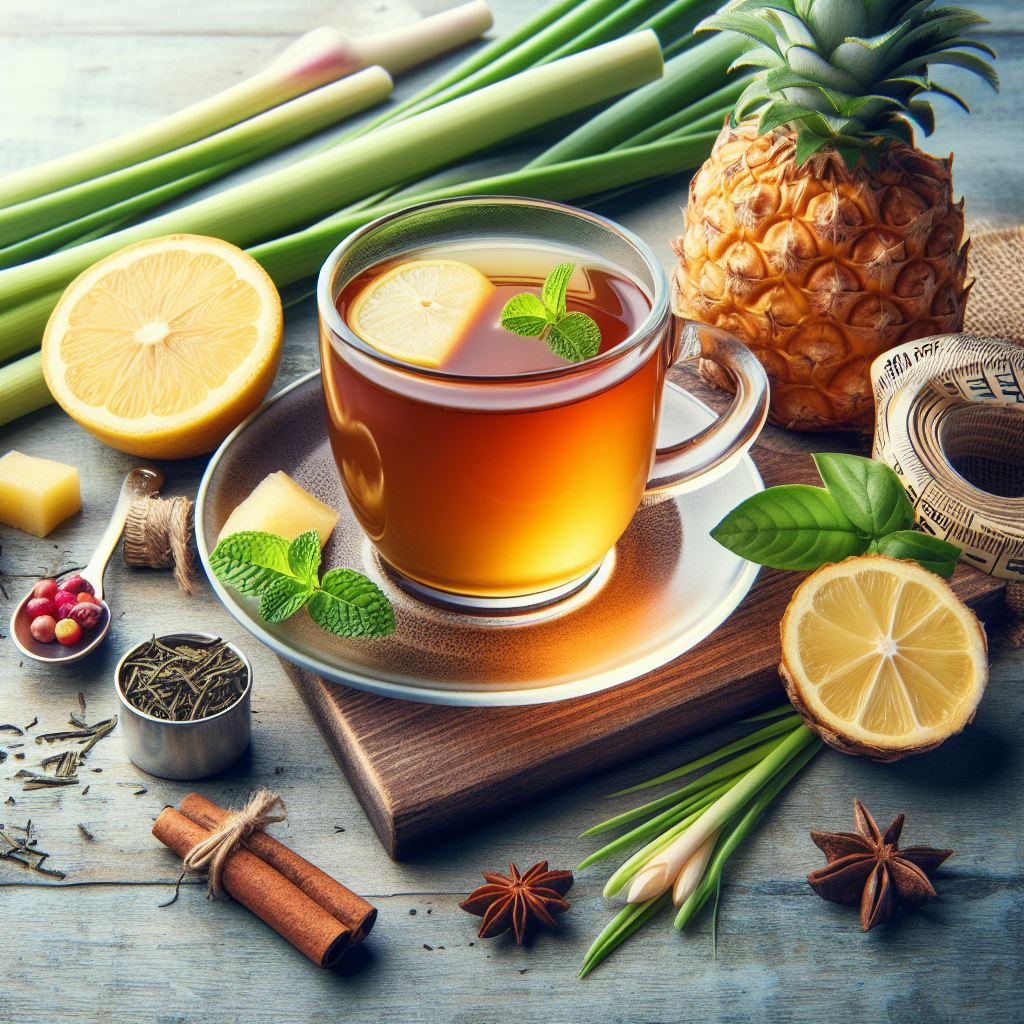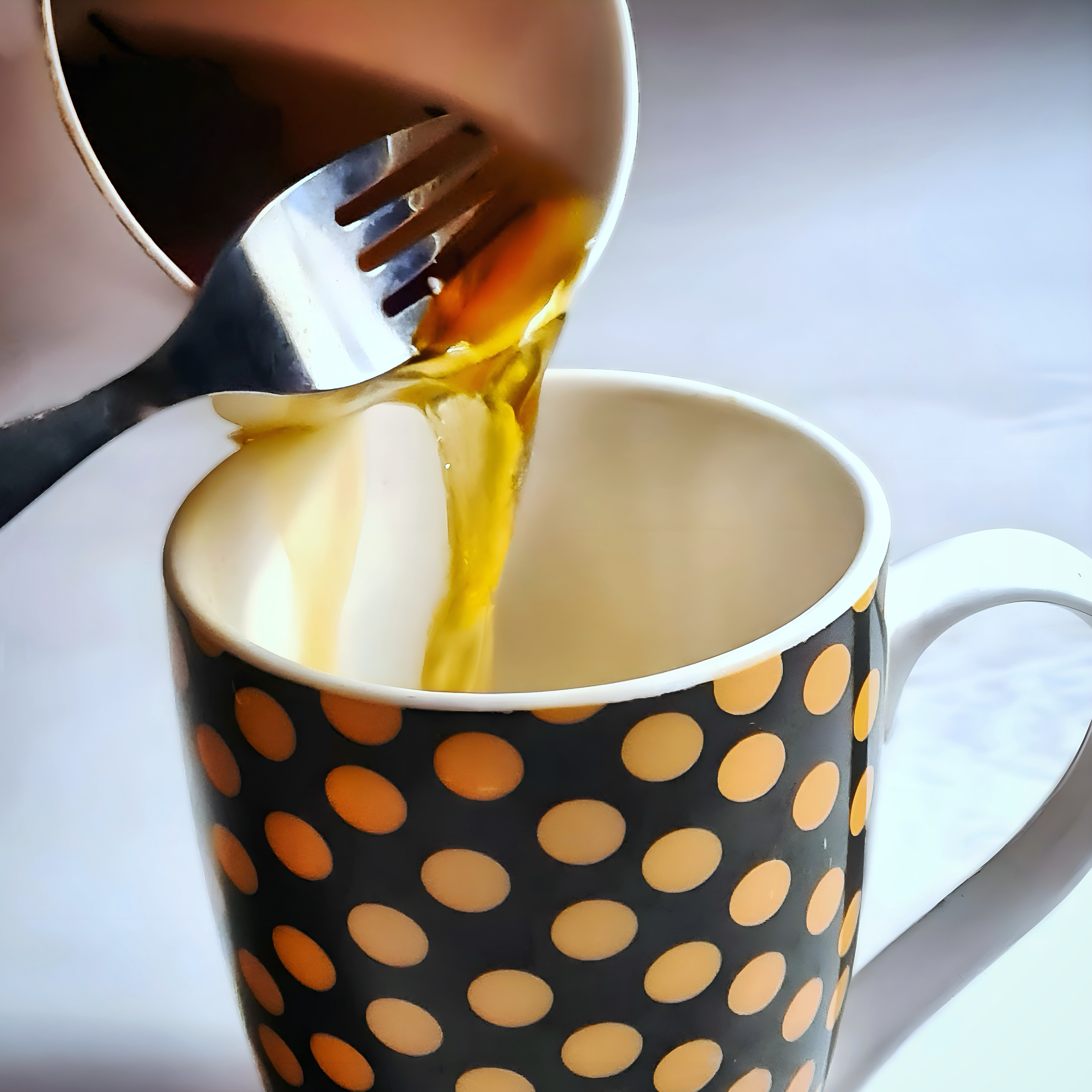Have you ever wondered what it would be like to drink a cup of nature? To taste the essence of the forest in every sip? To feel the vitality of the green world in your veins? If so, you might want to try pine needle tea, a delicious and nutritious beverage that has been enjoyed for centuries by various cultures around the world.
In this blog post, we will explore the wonders of pine needle tea and provide a step-by-step guide on how to make it. You will learn about its rich history, its unique health benefits, its diverse flavors, and its safety considerations. By the end of this post, you will be ready to embark on a refreshing journey into nature’s cup.

The Essence of Pine Needle Tea
Pine needle tea is a herbal infusion made from the fresh or dried needles of pine trees. Pine trees are evergreen conifers that belong to the Pinaceae family, which includes spruce, fir, larch, and cedar. There are over 100 species of pine trees, and most of them can be used to make tea.
Pine needle tea has a long and fascinating history. It is believed that the Native Americans were the first to discover its benefits, using it as a source of vitamin C and a remedy for scurvy. They also used it to treat various ailments, such as coughs, colds, infections, and wounds. Pine needle tea was also popular among the early European settlers, who learned about it from the natives and adopted it as a survival drink.
Pine needle tea is not only a historical drink, but also a healthy one. It is rich in antioxidants, which protect the cells from oxidative stress and prevent chronic diseases. It also contains immune-boosting compounds, such as vitamin C, vitamin A, and beta-carotene, which enhance the body’s resistance to infections and inflammation. Moreover, pine needle tea has potential anti-inflammatory benefits, as it may reduce the production of pro-inflammatory cytokines and modulate the immune response.
Choosing the Right Pine Needles

Not all pine needles are created equal. Some are more suitable for making tea than others, depending on their flavor, aroma, and safety. Here are some tips on how to choose the right pine needles for your tea:
- Select fresh, young, and aromatic needles. The best time to harvest pine needles is in the spring, when they are tender and full of flavor. You can also use needles that have fallen from the tree, as long as they are still green and fragrant. Avoid using brown, dry, or brittle needles, as they may have lost their nutrients and taste.
- Choose pine trees that are native to your region or that you can identify with certainty. Some of the most common and delicious pine trees for making tea are white pine, Scots pine, red pine, and ponderosa pine. However, be careful not to confuse pine trees with other conifers, such as yew, cypress, or juniper, which may be toxic or bitter. If you are unsure about the identity of a pine tree, consult a reliable guide or an expert before using its needles (see end of post for details on identifying pine trees).
- Forage or source pine needles responsibly. If you are harvesting pine needles from the wild, make sure you have permission from the landowner and that you follow the principles of ethical foraging. Do not take more than you need, and leave some needles on the tree for its health and growth. If you are buying pine needles from a store or online, make sure they are organic and pesticide-free, and that they come from a reputable supplier.
Harvesting and Preparing Pine Needles
Once you have chosen the right pine needles, you need to harvest and prepare them properly. Here are the steps to follow:
- Cut or pluck the needles from the branch, using a sharp knife or scissors. You can either use the whole needle or chop it into smaller pieces, depending on your preference. The smaller the pieces, the faster the extraction and the stronger the flavor.
- Rinse the needles under running water, and pat them dry with a clean cloth or paper towel. This will remove any dirt, insects, or other contaminants that may be on the needles.
- Optionally, you can blanch the needles in boiling water for a few seconds, and then drain them. This will help to remove some of the resin and bitterness from the needles, and to preserve their color and freshness.
Pine Needle Tea Brewing Techniques and Recipes

There are various ways to brew pine needle tea, depending on the desired strength and taste. Here are some of the most common techniques and recipes:
- Steeping: This is the simplest and most common method of making pine needle tea. Simply place a handful of pine needles (about 1/4 cup) in a teapot or a mug, and pour boiling water over them. Cover and let it steep for 10 to 15 minutes, or longer for a stronger brew. Strain and enjoy.
- Simmering: This is a more intense method of making pine needle tea, which extracts more flavor and nutrients from the needles. Place a handful of pine needles (about 1/4 cup) in a small saucepan, and cover them with water. Bring to a boil, and then lower the heat and simmer for 15 to 20 minutes, or longer for a stronger brew. Strain and enjoy.
- Cold infusion: This is a more gentle method of making pine needle tea, which preserves the delicate flavor and aroma of the needles. Place a handful of pine needles (about 1/4 cup) in a glass jar, and fill it with cold water. Cover and refrigerate for at least 8 hours, or overnight. Strain and enjoy.
You can also experiment with different ingredients to enhance the flavor and aroma of your pine needle tea. Here are some suggestions:
- Citrus zest: Adding some lemon, lime, orange, or grapefruit zest to your pine needle tea will give it a refreshing and zesty twist. Citrus zest also contains vitamin C and flavonoids, which boost the health benefits of the tea.
- Honey: Adding some honey to your pine needle tea will sweeten it and balance its bitterness. Honey also has antibacterial, antiviral, and anti-inflammatory properties, which complement the effects of the tea.
- Herbs: Adding some herbs to your pine needle tea will create a more complex and aromatic brew. Some of the best herbs to pair with pine needle tea are mint, rosemary, thyme, sage, and lavender.
Tasting and Pairings
To fully appreciate the flavors and aromas of pine needle tea, you need to taste it with attention and care. Here are some tips on how to do that:
- Use a clear glass or cup to observe the color and clarity of the tea. Pine needle tea usually has a light green or yellow hue, depending on the type of pine and the brewing method.
- Smell the tea before drinking it, and notice the different notes and nuances. Pine needle tea usually has a fresh, woody, and resinous aroma, with hints of citrus, mint, or spice, depending on the ingredients added.
- Sip the tea slowly, and let it roll over your tongue and palate. Notice the different sensations and tastes. Pine needle tea usually has a mild, sweet, and slightly bitter flavor, with a refreshing and soothing aftertaste.
You can also pair your pine needle tea with some food items that complement its unique characteristics. Here are some suggestions:
- Light pastries: Pine needle tea goes well with light and flaky pastries, such as croissants, scones, or biscuits. The buttery and crispy texture of the pastries contrasts with the smooth and delicate flavor of the tea.
- Citrus-based desserts: Pine needle tea pairs well with citrus-based desserts, such as lemon bars, orange cake, or grapefruit sorbet. The tangy and sweet flavor of the desserts enhances the zesty and refreshing flavor of the tea.
- Savory snacks: Pine needle tea also matches well with savory snacks, such as cheese, crackers, or nuts. The salty and nutty flavor of the snacks balances the bitter and resinous flavor of the tea.
Safety Considerations and Possible Side Effects of Pine Needle Tea
Pine needle tea is generally safe and beneficial for most people, but there are some precautions and potential side effects to be aware of. Here are some of them:
- Allergy or sensitivity: Some people may be allergic or sensitive to pine needles or other conifers, and may experience symptoms such as rash, itching, swelling, or difficulty breathing after consuming pine needle tea. If you have a known allergy or sensitivity to pine or related plants, avoid drinking pine needle tea or consult your doctor before trying it.
- Pregnancy or breastfeeding: Pine needle tea may contain compounds that can affect the hormonal balance or the uterine activity of pregnant or breastfeeding women, and may cause complications such as miscarriage, premature labor, or reduced milk supply. If you are pregnant or breastfeeding, avoid drinking pine needle tea or consult your doctor before trying it.
- Medication or health condition: Pine needle tea may interact with certain medications or health conditions, and may affect their effectiveness or cause adverse effects. For example, pine needle tea may increase the risk of bleeding if taken with blood thinners, or may lower the blood sugar levels if taken with diabetes medications. If you are taking any medication or have any health condition, consult your doctor before drinking pine needle tea.
Identifying Pine Trees
Here are some descriptions of the types of pine trees that you can and cannot use for tea. Please note that this list is not exhaustive and that you should always consult a reliable guide or an expert before using any pine needles for tea if you are unsure. There are many types of pine trees, so these are just some of the most common ones:
Pine trees that are safe to use:
White Pine:
White pine (Pinus strobus) is a large evergreen tree with soft, blue-green needles in bundles of five. The needles are 2 to 6 inches long and have white lines on the lower surface. The bark is smooth and gray on young trees, but becomes dark and furrowed on old trees. The cones are 4 to 8 inches long, slender, and curved. White pine is native to eastern North America and is the state tree of Maine and Michigan.
Scots Pine:
Scots pine (Pinus sylvestris) is a medium-sized evergreen tree with twisted, blue-green needles in pairs. The needles are 1.5 to 3 inches long and have white lines on both surfaces. The bark is orange-red and flaky on the upper trunk and branches, but gray and fissured near the base. The cones are 1.5 to 3 inches long, egg-shaped, and have a small prickle on each scale. Scots pine is native to northern Europe and Asia and is the national tree of Scotland.
Red Pine:
Red pine (Pinus resinosa) is a tall evergreen tree with stiff, dark green needles in pairs. The needles are 4 to 6 inches long and have two whitish lines on the lower surface. The bark is reddish-brown and scaly on young trees, but becomes gray and ridged on old trees. The cones are 1.5 to 2.5 inches long, ovoid, and have a small prickle on each scale. Red pine is native to northeastern North America and is also called Norway pine.
Himalayan Cedar:
Himalayan cedar (Cedrus deodara) is a fine-textured evergreen tree in the pine family, native to the Himalayas. It has a pyramidal shape when young, with pendulous or weeping branches. The needles are needle-like, mostly 2.5–5 cm long, blue-green, and have white lines on the lower surface. The cones are barrel-shaped, 7–13 cm long, and disintegrate when mature.
Japanese Red Pine:
Japanese red pine (Pinus densiflora) is a graceful, pine-like tree with a lacy, delicate appearance. It has bright green needles in pairs that are 3 to 5 inches long and have a whitish band on the upper surface. The bark is reddish-brown and peels in thin scales. The cones are 1.5 to 2.5 inches long, cylindrical, and yellow-brown. Japanese red pine is native to Japan, Korea, China, and Russia and is also called Korean pine.
Spruce:
Spruce (Picea spp.) is a genus of about 40 species of evergreen coniferous trees in the pine family, native to the northern temperate and boreal regions of the Earth. Spruces have needle-like leaves that are four-sided and attached singly to small peg-like structures on the branches. The cones are cylindrical, 4–6 cm long, and hang downwards after pollination. The bark is thin, scaly, and brown.
Fir:
Fir (Abies spp.) is a genus of more than 40 species of evergreen coniferous trees in the pine family, native to North and Central America, Europe, Asia, and northern Africa. Firs have flat, needle-like leaves that are attached directly to the branch with a base resembling a suction cup. The cones are erect, 5–25 cm long, and disintegrate at maturity to release the winged seeds. The bark is smooth and gray, often with resin blisters. This tree is most commonly used for Christmas trees.
Pine Trees that are not safe to use:
Loblolly Pine:
Loblolly pine (Pinus taeda) is a fast-growing evergreen tree with yellow-green needles in bundles of three. The needles are 6 to 9 inches long and have finely toothed margins. The bark is dark gray and furrowed on old trees, but reddish-brown and scaly on young trees. The cones are 3 to 6 inches long, ovoid to cylindrical, and have a sharp prickle on each scale. Loblolly pine is native to the southeastern United States and is one of the most common pine trees in the country.
Norfolk Pine:
Norfolk pine (Araucaria heterophylla) is an evergreen conifer with a symmetrical, pyramidal shape and a dense crown. It has needle-like leaves that are 0.5 to 1 inch long and grow in whorls around the branches. The bark is gray-brown and smooth on young trees, but becomes rough and scaly on old trees. The cones are 3 to 4 inches long, spherical, and brown. Norfolk pine is native to Norfolk Island in the Pacific Ocean and is not a true pine, but a member of the Araucaria family.
Common Juniper:
Common juniper (Juniperus communis) is an evergreen shrub or small tree with needle-like leaves that are 0.2 to 0.6 inches long and have a single white band on the upper surface. The leaves are arranged in whorls of three and are prickly to the touch. The bark is brown and peels in thin strips. The female cones are berry-like, fleshy, and purple, and contain two to four seeds. Common juniper is native to the northern hemisphere and is the most widespread conifer in the world.
Lodgepole Pine:
Lodgepole pine (Pinus contorta) is a slender, straight, and fast-growing evergreen conifer in the pine family, native to western North America. It has dark green needles in bundles of two or three, 3.5–7.5 cm long, and yellow-brown cones, 3–7 cm long, with prickles on the scales. The bark is thin, scaly, and dark brown. Lodgepole pine is one of the first trees to regenerate after a fire, as its cones are sealed with resin and require heat to open.
Monterey Pine:
Monterey pine (Pinus radiata) is a large, graceful, and widely planted evergreen conifer in the pine family, native to the central coast of California and Mexico. It has bright green needles in bundles of three, 12–20 cm long, and oval or cylindrical cones, 8–15 cm long, without stalks. The bark is thin, scaly, and grayish-brown. Monterey pine is a versatile and fast-growing timber tree, but it faces threats from a fungal disease called pine pitch canker.
Yew:
Yew (Taxus spp.) is a genus of about eight species of evergreen trees and shrubs in the yew family, native to the Northern Hemisphere. Yews have dark green, leathery, and narrow leaves, 1–4 cm long, with a pointed tip. The seeds are enclosed in a red, fleshy, cup-like structure called an aril, which is attractive to birds. The bark is thin, scaly, and brown. Yews are long-lived and often associated with death and doom, but they also provide food and shelter for wildlife.
Ponderosa Pine:
Ponderosa pine (Pinus ponderosa) is a large, tall, and widely distributed evergreen conifer in the pine family, native to western North America. It has yellow-green needles in bundles of two or three, 9–20 cm long, and ovoid or cylindrical cones, 7–17 cm long, with a sharp prickle on each scale. The bark is orange-red to yellow-brown, with broad, scaly plates. Ponderosa pine is an important timber tree and a source of food and habitat for many animals.
Conclusion
Pine needle tea is a delightful and nutritious beverage that has been enjoyed for centuries by various cultures around the world. It is easy and fun to make, and it offers a refreshing and soothing experience. By following the steps and tips in this blog post, you can discover the delights of pine needle tea and enjoy a cup of nature anytime you want.
We hope you found this blog post informative and engaging. If you did, please share it with your friends and family, and leave us a comment below. We would love to hear your feedback and suggestions. And don’t forget to check out our other blog posts on tea-related topics, such as the best teas for different seasons, the health benefits of herbal teas, and the art of tea tasting.
Thank you for reading, and happy brewing!
Discover More Tea-Related Articles:
- Corn Silk Tea: How to Make One of the Most Unique, Healthy Teas
- Teh Tarik: Malaysian Pulled Tea & How to Make It
- Tea for Anxiety: The Best Natural Remedies For Anxiety
- Tea Processing: The Ultimate Journey from Plant to Cup
- Oolong Tea Benefits and Beyond: Everything You Need to Know





Leave a Comment